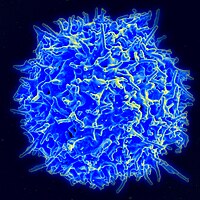
Photo from wikipedia
Regulatory T cells (Tregs) play a critical role in controlling autoreactive T cells, and quantitative and/or qualitative deficiencies in Tregs are associated with autoimmune diseases, including type 1 diabetes (T1D),… Click to show full abstract
Regulatory T cells (Tregs) play a critical role in controlling autoreactive T cells, and quantitative and/or qualitative deficiencies in Tregs are associated with autoimmune diseases, including type 1 diabetes (T1D), in both humans and mice. Both the incidence of T1D and percentages of peripheral Tregs in NOD mice vary considerably between animal facilities. In our animal facility, the incidence of T1D in NOD mice is high at 90-100% and the percentages of peripheral CD4+Foxp3+ cells in ~9-10-week-old female NOD mice are decreased compared to control (B6) mice shortly before high glucose is first detected (~12 weeks). These data suggest that there is an imbalance between Tregs and potentially pathogenic effector T cells at this age that could have significant impact on disease progression to overt diabetes. The goal of the current study was to investigate mechanisms that play a role in peripheral Treg : T effector cell balance in NOD mice, including differences in persistence/survival, peripheral homeostatic proliferation, and thymic production and output of CD4+ T cells. We found no differences in persistence/survival or homeostatic proliferation of either Tregs or effector T cells between NOD and B6 mice. Furthermore, although the percentages and absolute numbers of CD4+Foxp3+ cells in thymus were not decreased in NOD compared to B6 mice, the percentage of CD4+ recent thymic emigrants (RTE) that were Foxp3+ was significantly lower in 9-week-old NOD mice. Interestingly, the thymic output of CD4+Foxp3+ cells was not lower in NOD mice, whereas the thymic output of CD4+Foxp3− cells was significantly higher in NOD mice at that age compared to B6 mice. These data suggest that the higher thymic output of CD4+Foxp3− T cells contributes, at least in part, to the lower percentages of peripheral CD4+Foxp3+ Tregs in NOD mice and an imbalance between Tregs and T effector cells that may contribute to the development of full-blown diabetes.